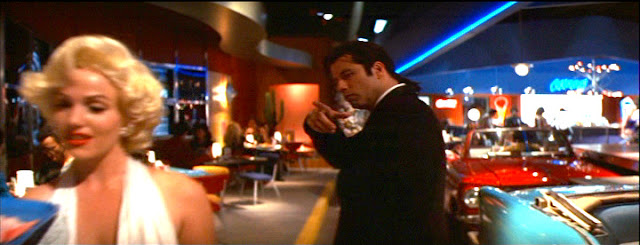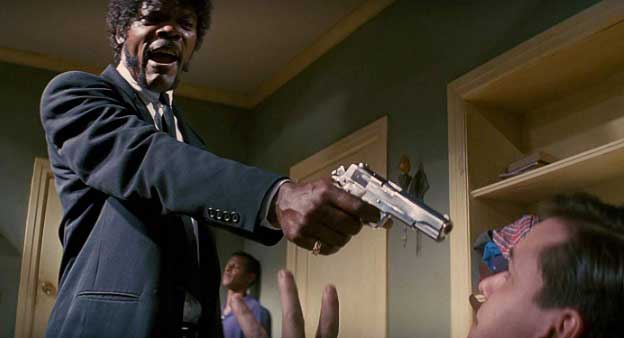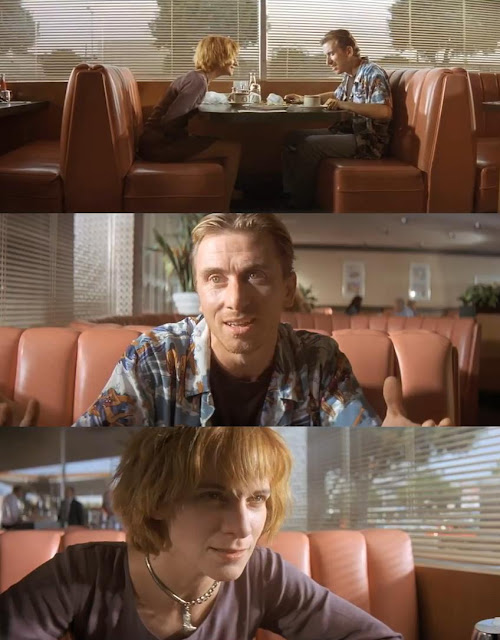Social, Cultural and Political Contexts of Pulp Fiction
Questions in the exam could focus specifically on the way that social, cultural or political contexts influence Pulp Fiction, and the ways that audience appreciation of these contexts can enhance their understanding and appreciation of the film. It is unlikely that you will be asked a specific question about political contexts (as Pulp Fiction is not political in nature) but answers to questions on social and/or cultural contexts are likely to be dominated by discussion of the ways that Pulp Fiction can be considered a postmodern film, the ways it is influenced by other films and popular culture (through Tarantino's use of intertextuality and the ways he pays homage to existing movies) and even the ways that Pulp Fiction has subsequently influenced popular culture (through many 'copycat' movies, through the popularising of certain songs and musical artists and even through advertising, such as the Direct Line car insurance adverts which feature music and one of the characters from the film in their campaign). To refresh your memory about the key ideas surrounding these areas, click on the links below.
Remember, questions on social and cultural contexts will require you to discuss, in detail, certain scenes from Pulp Fiction - so make sure you have at least two scenes that you can recall in detail. In reality (time permitting) it would be a good idea to also mention at least one other scene; remember, that you are writing a Film Studies essay and, therefore, examiners will expect you to support your points at all times with discussion of examples from the film.
Opening and closing scenes are always useful to know in detail - though remember that this is slightly complicated by the fact that much of Pulp Fiction is told out of chronological order (so, you may consider Captain Coons' Gold Watch monologue to be the opening moment of the story - looking at the film this way foregrounds the narrative significance of the gold watch - whilst the diner scene with Honey Bunny and Pumpkin is the opening scene as presented in the plot). Try, also, to memorise at least one other key scene - and make sure that you are able to make brief passing references to a number of other moments in Pulp Fiction.
The majority of your essay, then, will focus on postmodernism, an area we have already covered. Please click on the link below to refresh your memory about what to write. I have also included a link to the post on sound, which will help you with any points you want to make on the ways that Tarantino uses music and how his music choices have subsequently made their way into popular culture.
Pulp Fiction depicts a non-specific, almost timeless, LA. Indeed the film's rich use of nostalgic music and mise-en-scene coupled with a highly unconventional form of narrative (not to mention the frequent use of intertextuality) means the film can be best located in postmodern cultural context. As such, the film has a rootless quality that does not allow for the same kind of explicit social, cultural or historical analysis that you may find with many other films. Pulp Fiction is one of those cultural texts which emerged in the early 1990s that began the trend for ever increasingly postmodern play in the media as a whole.
Typical questions related to the influence of social and cultural contexts on Pulp Fiction can be found below. It is important that you attempt them, combining the notes above (and those found in the posts on postmodernism and sound) with your own analysis of key scenes. When practicing essays it will help with your revision if you re-watch moments from the film and pick appropriate scenes to analyse.
One important point to remember is that exam questions may include the term political context alongside social and cultural contexts - don't worry, just ignore political context and focus on the other two!
1. Discuss how far your chosen film reflects the social, cultural or political contexts of the time. Make detailed reference to particular sequences in your answer.
OR
OR
3. 'Knowing more about a film's social and/or cultural contexts can enhance your appreciation and understanding of that film.' How far is this true in the film option you have studied? Make reference to key sequences from the film you have watched.
OR
4. 'Films are always shaped by their social and cultural contexts.' With detailed reference to key sequences, discuss your chosen film option in relation to this statement.








Comments
Post a Comment